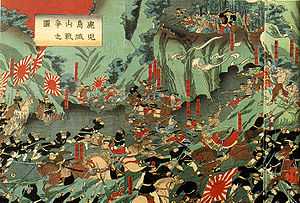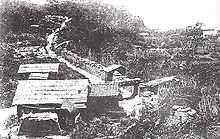Battle of Shiroyama
| Battle of Shiroyama 城山の戦い | |||||||
|---|---|---|---|---|---|---|---|
| Part of the Satsuma rebellion | |||||||
 Japanese depiction of the Battle of Shiroyama. Saigō Takamori can be seen in red and black uniform directing his troops in the upper right corner. | |||||||
| |||||||
| Belligerents | |||||||
| Imperial Japanese Army | Samurai of Satsuma | ||||||
| Commanders and leaders | |||||||
| Yamagata Aritomo | Saigō Takamori † | ||||||
| Strength | |||||||
| 30,000 troops | About 500 samurai | ||||||
| Casualties and losses | |||||||
| Unknown | All | ||||||
The Battle of Shiroyama (城山の戦い Shiroyama no tatakai) took place on 24 September 1877, in Kagoshima, Japan. [1] It was the final battle of the Satsuma Rebellion, where the heavily outnumbered samurai under Saigō Takamori fought their last stand against Imperial Japanese Army troops under the command of Generals Yamagata Aritomo and Kawamura Sumiyoshi. The battle culminated in the annihilation of Saigō's army as well as his death, marking the end of the Satsuma Rebellion.
Summary
Following defeat at the Siege of Kumamoto Castle and in other battles in central Kyūshū, the surviving remnants of the samurai forces loyal to Saigō Takamori fled back to Satsuma, seizing the hill of Shiroyama overlooking Kagoshima on 1 September 1877.
Imperial army troops under the command of General Yamagata Aritomo and marines under the command of Admiral Kawamura Sumiyoshi began arriving soon after, and the rebels were surrounded. After combat losses and defections, Saigō had only about 500 samurai remaining of a force of over 20,000 which had besieged the government garrison in the city of Kumamoto only six weeks earlier.
With 30,000 troops,[2] Yamagata greatly outnumbered Saigō. Having been outfought and outmaneuvered so often in the past, however, Yamagata was determined to leave nothing to chance. The imperial troops spent several days constructing an elaborate system of ditches, walls and obstacles to prevent another breakout. The five government warships in Kagoshima harbor added their firepower to Yamagata's artillery, and began to systematically reduce the rebel positions, firing more than 7,000 shells.
Saigō defended his position with limited musket support, and no cannon. Saigō's force was reduced to melting down metal statuettes that local civilians smuggled in, and casting the metal into bullets. Medical supplies consisted of one carpenter's saw for amputations and a few rags for bandages. Yamagata sent a letter to Saigō, which entreated him to surrender, but bushido honor would not let Saigō surrender.[1]

Yamagata's battle plan was to assault Saigo's position from all sides at once. Units were forbidden to assist one another without express permission. If a unit retreated with enemy troops in pursuit, the neighboring units were to fire into the area indiscriminately, killing their own men if necessary to prevent Saigō from escaping.[1]
Following an intensive artillery bombardment the night of 24 September, imperial forces stormed the mountain in the early morning hours. The samurai, under heavy fire, charged the lines of the imperial army, which had not been trained for close-quarter sword fighting. In just a few minutes the once organized line turned into discord. Highly skilled samurai swordsmanship prevailed against an army with very little traditional training. For a short time Saigō's lines held, but was forced back due to weight of numbers. By 6 a.m., only 40 rebels were still alive. Saigō was wounded in the femoral artery and stomach. Losing blood rapidly, he asked to find a suitable spot to die. One of his most loyal followers, Beppu Shinsuke, carried him further down the hill on his shoulders. Legend says that Beppu acted as kaishakunin and aided Saigō in committing seppuku before he could be captured.[3] However, other evidence contradicts this, stating that Saigō in fact died of the bullet wound and then had his head cut off by Beppu in order to preserve his dignity.[1]
Aftermath
On 22 February 1889, Emperor Meiji pardoned Saigō posthumously.[4] Statues in Ueno Park, Tokyo and near the ruins of Kagoshima Castle stand in his memory.
This battle inspired the final scenes of the 2003 movie, The Last Samurai.
See also
References
- ↑ 1.0 1.1 1.2 1.3 "Satsuma Rebellion: Satsuma Clan Samurai Against the Imperial Japanese Army". Military History Magazine. 12 June 2006.
- ↑ Hickman, Kennedy. "Battle of Shiroyama - Satsuma Rebellion Battle of Shiroyama". about.com: Military History. Retrieved 2010-09-24.
- ↑ Williamson, Mitch. "The Satsuma Rebellion". Weapons and Warfare. Retrieved 11 December 2013.
- ↑ Perkins, Dorothy. Japan Goes to War: A Chronology of Japanese Military Expansion. Diane Publishing.
Further reading
- Keane, Donald (2005). Emperor Of Japan: Meiji And His World, 1852-1912. Columbia University Press. ISBN 0-231-12341-8.
- Mounsley, Augustus H (1979). Satsuma Rebellion: An Episode of Modern Japanese History. University Publications of America. ISBN 0-89093-259-X.
- Ravina, Mark (2004). The Last Samurai : The Life and Battles of Saigō Takamori. Wiley. ISBN 0-471-08970-2.
External links
- Satsuma Rebellion: Satsuma Clan Samurai Against the Imperial Japanese Army
- Dana Jasek. "Satsuma Rebellion ends". Archived from the original on 14 March 2007. Retrieved 2007-02-16.
- Satsuma Rebellion: Battle of Shiroyama
Coordinates: 31°36′00″N 130°33′00″E / 31.6000°N 130.5500°E